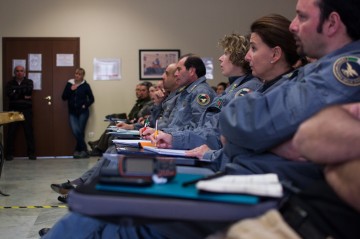Conflicts always have a source: the conflict that sees people and wolves on opposite sides has one of its commonest and strongest motivations in the predation on domestic livestock in the summer pastures. This is one of the main problems in the long-term coexistence between wolf and human activities: many shepherds believe that the presence of wolves in the mountain pastures lead to an intolerable increase in costs, labour and stress, and that the presence of wolves should be actively contained in many areas, and in some cases, eliminated altogether.
Damage to livestock and the tensions that arise are highest in the period immediately following the return of wolves into a new territory: this tends to decrease over time as measures to prevent attacks are put in place and gradually that the management model of the pasture adapts to the new situation dictated by the presence of a predator.
For decades, in fact, in the absence of wolves, the shepherds in the Alps have lost the habit of living with large carnivores and now have to adapt to using the appropriate tools to prevent attacks and minimize the times when sheep, goats and cows are left unattended. This means higher expenses and an increase in hours of work, in conditions which are already difficult and with often modest profit margins. These problems are real and serious: and are not to be understated, but addressed in a dialogue with stakeholders and farmers. Well managed sheep farming in the mountains is of ecological and economic value and of priority interest for the region and for protected areas: the maintenance of habitats linked to the Alpine pastures and meadows, the quality of products from high pastures, the landscape value, ecotourism and also the cultural elements of farming are to be protected without ifs and buts.
Much has already been done and much remains to be done in the field of prevention of attacks on livestock: But not all solutions have proven to be equally effective in all cases and the means of prevention can still be perfected. Not to mention that new measures are to be designed and put in place with regard to the attacks on cattle. Bridging these gaps is one of the objectives of LIFE WOLFALPS.
LIFE WOLFALPS is prevention
Actions (A7, A9, C2, C3, D5)
The project offers the possibility of taking preventive measures and experience to the areas of recent colonization and to test the validity of new instruments in the Western Alps, where the wolves have been stable for several years.
LIFE WOLFALPS also provides for the systematic analysis of the effectiveness of different prevention tools: A useful study that has never been done before. In the absence of such an analysis, so far only local strategies of an opportunistic nature have been developed, which sometimes have served only to repeat the errors, with little success in limiting actual damages and resolution of conflicts.
Testing the various systems of prevention and the development of ad hoc grazing strategies, combined with the analysis of the vulnerability of the pastures and proper information for breeders are aimed at reducing conflicts: it is hoped that with decreasing losses the level of hostility of farmers against the wolves will lower and the quality of coexistence between the predator and the shepherds improve.


